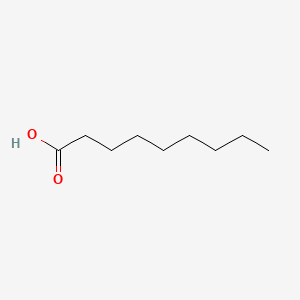| MeSH term | MeSH ID | Detail |
|---|---|---|
| Dermatitis, Contact | D003877 | 59 associated lipids |
| Facial Dermatoses | D005148 | 7 associated lipids |
| Hypersensitivity | D006967 | 22 associated lipids |
| Arteriosclerosis | D001161 | 86 associated lipids |
| Seizures | D012640 | 87 associated lipids |
| Dermatitis, Allergic Contact | D017449 | 20 associated lipids |
| Riboflavin Deficiency | D012257 | 10 associated lipids |
| Lichen Planus | D008010 | 3 associated lipids |
| Keratosis | D007642 | 9 associated lipids |
| Tick Infestations | D013984 | 4 associated lipids |
NONANOIC ACID
NONANOIC ACID is a lipid of Fatty Acyls (FA) class. Nonanoic acid is associated with abnormalities such as megalocytosis, Hypos, Renal tubular disorder, Respiratory Distress Syndrome, Adult and Little's Disease. The involved functions are known as Gene Expression, Signal Transduction, Regulation, Cell Cycle and Force. Nonanoic acid often locates in Membrane, Protoplasm, Body tissue, Extracellular and Cell membrane. The associated genes with NONANOIC ACID are cysteinylglycine, glycylsarcosine, arginine methyl ester, GLI3 gene and ADRBK1 gene. The related lipids are 1-octen-3-ol, Butyric Acids, palmitoleic acid, pentadecanoic acid and stearic acid.
Cross Reference
Introduction
To understand associated biological information of NONANOIC ACID, we collected biological information of abnormalities, associated pathways, cellular/molecular locations, biological functions, related genes/proteins, lipids and common seen animal/experimental models with organized paragraphs from literatures.
What diseases are associated with NONANOIC ACID?
NONANOIC ACID is suspected in megalocytosis, Hypos, Renal tubular disorder, Respiratory Distress Syndrome, Adult, Little's Disease and other diseases in descending order of the highest number of associated sentences.
Related references are mostly published in these journals:
- Am. J. Physiol. Heart Circ. Physiol. (1)
- Am. J. Physiol. Lung Cell Mol. Physiol. (1)
- Am. J. Physiol. Renal Physiol. (1)
- Others (1)
| Disease | Cross reference | Weighted score | Related literature |
|---|
Possible diseases from mapped MeSH terms on references
We collected disease MeSH terms mapped to the references associated with NONANOIC ACID
PubChem Associated disorders and diseases
What pathways are associated with NONANOIC ACID
There are no associated biomedical information in the current reference collection.
PubChem Biomolecular Interactions and Pathways
Link to PubChem Biomolecular Interactions and PathwaysWhat cellular locations are associated with NONANOIC ACID?
Visualization in cellular structure
Associated locations are in red color. Not associated locations are in black.
Related references are published most in these journals:
| Location | Cross reference | Weighted score | Related literatures |
|---|
What functions are associated with NONANOIC ACID?
Related references are published most in these journals:
| Function | Cross reference | Weighted score | Related literatures |
|---|
What lipids are associated with NONANOIC ACID?
Related references are published most in these journals:
| Lipid concept | Cross reference | Weighted score | Related literatures |
|---|
What genes are associated with NONANOIC ACID?
Related references are published most in these journals:
| Gene | Cross reference | Weighted score | Related literatures |
|---|
What common seen animal models are associated with NONANOIC ACID?
There are no associated biomedical information in the current reference collection.
NCBI Entrez Crosslinks
All references with NONANOIC ACID
Download all related citations| Authors | Title | Published | Journal | PubMed Link |
|---|---|---|---|---|
| Montgomery JA et al. | Metabolism of deuterium-labeled nonanoic acids in the riboflavin-deficient rat model of multiple acyl-CoA dehydrogenase deficiency. | 1991 | Biol. Mass Spectrom. | pmid:2054391 |
| Lusby WR et al. | Comparison of known and suspected pheromonal constituents in males of African ticks, Amblyomma hebraeum Koch and Amblyomma variegatum (Fabricius). | 1991 | Exp. Appl. Acarol. | pmid:1786745 |
| Lindberg M et al. | Differential effects of sodium lauryl sulphate and non-anoic acid on the expression of CD1a and ICAM-1 in human epidermis. | 1991 | Acta Derm. Venereol. | pmid:1684465 |
| Hayes ML and Stobart HJ | The effects of medium chain fatty acids and fluoride on fissure caries in Wistar rats. | 1990 | Arch. Oral Biol. | pmid:2076059 |
| Agner T and Serup J | Individual and instrumental variations in irritant patch-test reactions--clinical evaluation and quantification by bioengineering methods. | 1990 | Clin. Exp. Dermatol. | pmid:2311276 |
| Winter's skin. | 1990 | Lancet | pmid:1967728 | |
| Agner T and Serup J | Skin reactions to irritants assessed by non-invasive bioengineering methods. | 1989 | Contact Derm. | pmid:2670419 |
| Willis CM et al. | Epidermal damage induced by irritants in man: a light and electron microscopic study. | 1989 | J. Invest. Dermatol. | pmid:2794551 |
| Agner T and Serup J | Seasonal variation of skin resistance to irritants. | 1989 | Br. J. Dermatol. | pmid:2803958 |
| Borghi A et al. | Isolation and structure determination of two new analogs of teicoplanin, a glycopeptide antibiotic. | 1989 | J. Antibiot. | pmid:2523370 |
